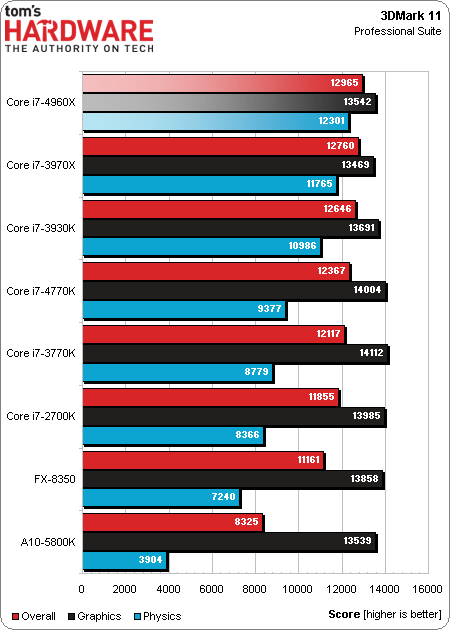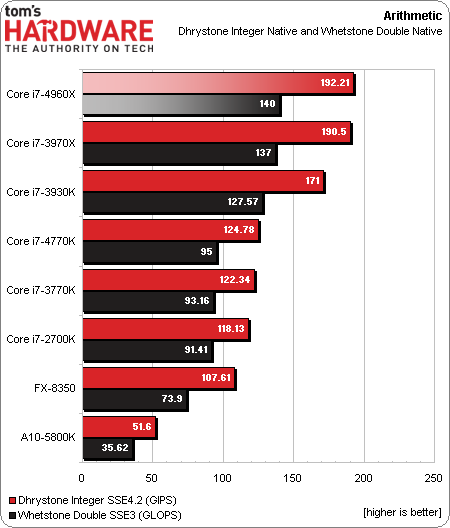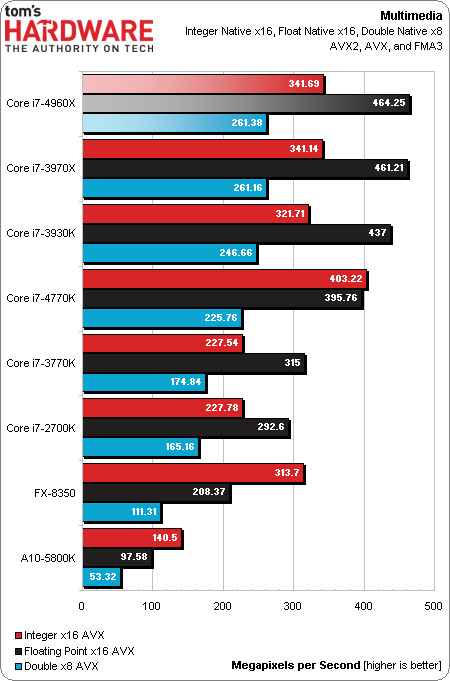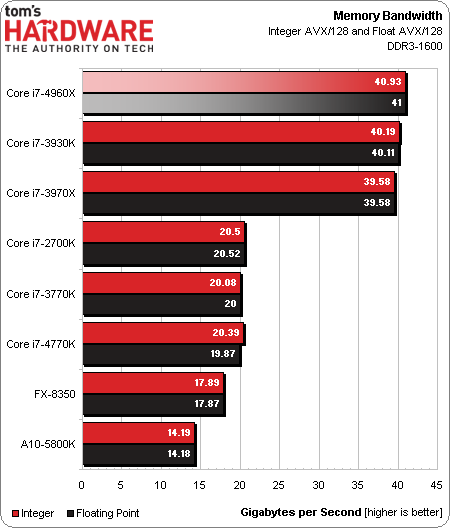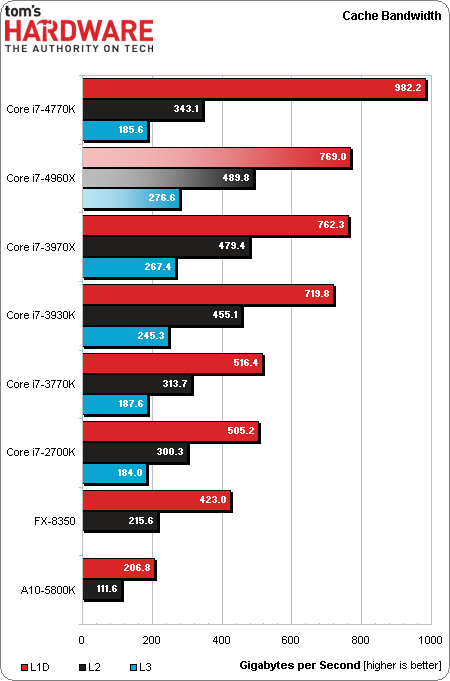Intel Core i7-4960X Review: Ivy Bridge-E, Benchmarked
Results: Synthetics
Using the same GeForce GTX Titan as our Haswell launch coverage, we see that Ivy Bridge-E doesn’t do anything for single-card graphics performance in 3DMark 11 (which is what we’d expect, given that both platforms yield a full 16 lanes at 8 GT/s).
In contrast, the processor-bound Physics module demonstrates a small bump in favor of the Core i7-4960X over -3970X. More pronounced is the -4960X’s 30%+ improvement over Core i7-4770K.
There’s very little gain over the Sandy Bridge-E flagship in SiSoftware’s Sandra Arithmetic sub-test.
The same goes for the Multimedia benchmark. In fact, Core i7-4770K yields better numbers in the integer component thanks to its AVX 2 support.
It’s possible that we could get more memory bandwidth from Core i7-4960X using a quad-channel DDR3-1866 memory kit. However, we only had access to 1600 MT/s for this story, so we used the same G.Skill kit from our Core i7-4770K launch piece. We already know this platform isn’t particularly bandwidth-constrained on the desktop, though, so we don’t expect any real-world benefit beyond this 41 GB/s mark.
When we sort by L1 cache throughput, the Haswell architecture’s doubled theoretical max yields almost 1 TB/s, while Ivy Bridge-E ducks in under 800 GB/s. On paper, Haswell should also push twice as much L2 bandwidth as well. We haven’t observed this yet, though. In contrast, Core i7-4960X, sporting six cores with 256 KB of L2 each, pushes more aggregate bandwidth, nearly hitting 500 GB/s. The extra cores also help with shared L3 bandwidth, given more stops along the ring bus.
Get Tom's Hardware's best news and in-depth reviews, straight to your inbox.
-
Someone Somewhere Probably would have been nice to be 8-core. Isn't the actual die on these things just a cut-down 12-core chip? Think I read that somewhere.Reply
EDIT: Minor error:
surface alongside Haswell-based 9-series chipsets
Shouldn't that be Broadwell? -
designasaurus There's a rumor going around that Ivy-E is going to have a soldered heatspreader instead of using thermal paste. Obviously this would be a big differentiator for enthusiasts picking between Haswell and Ivy-E. Given your access to Ivy-E, do you guys at Tom's have any opinions on this rumor?Reply -
killerchickens I bet it overclocks like a beast. :)Reply
Lol now time to spend $1000 to save on my power bill. -
ingtar33 about all i'd expect. shame really, but it looks like the enthusiast market is at a standstill till AMD starts to compete again.Reply -
sna too early to judge...Reply
The 6 cores ivyBridge-e "K" version is the real thing.
and I dont get it , how Tomshardwae fails to say about the SandyBridge-e not having PCIE 3.0 support , while the ivy-E has PCIe 3.0 support . this is a Big factor here. -
ingtar33 Reply11172422 said:too early to judge...
The 6 cores ivyBridge-e "K" version is the real thing.
and I dont get it , how Tomshardwae fails to say about the SandyBridge-e not having PCIE 3.0 support , while the ivy-E has PCIe 3.0 support . this is a Big factor here.
they did say it. You didn't read the beginning of the review. Of course pci-e 3.0 is a gimmick and not a reason to buy a new 2011 mb and ib-e chip... and it will remain a marketing gimmick untill gpus can actually be bottlenecked by pci-e 2.0 x16... high end gpus barely bottleneck on pci-e 2.0 x8 atm... it will be a little while (another generation or 3) before gpus will NEED pci-e 3.0.
-
Someone Somewhere Replyofficial PCI Express 3.0 compliance (remember, Sandy Bridge-E only claimed 8 GT/s signaling support), and 22 nm manufacturing.
That's pretty much saying it did it unofficially.
Besides, you have to look hard to find something bottlenecked by PCIe2.0x8; even high-end GPUs won't run into bandwidth limitations. -
CommentariesAnd More WOW !!!!!!! So Intel is expecting someone to spend another 1000 bucks just for a 10-20% boost. Yay!!!!!!!! This is Ivy Bridge-E. I am getting it , YAY!!!!!!!!!!!!!Reply -
shin0bi272 still no gaming benchmarks eh? I guess I'll save my money and stick with my i7-920 for a little bit longer.Reply
